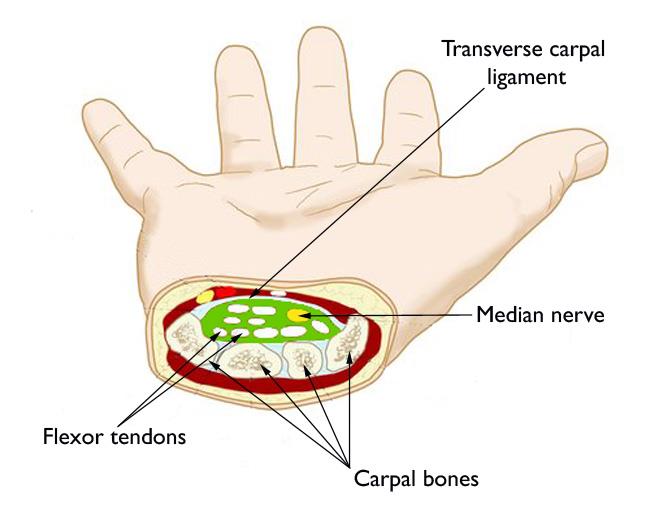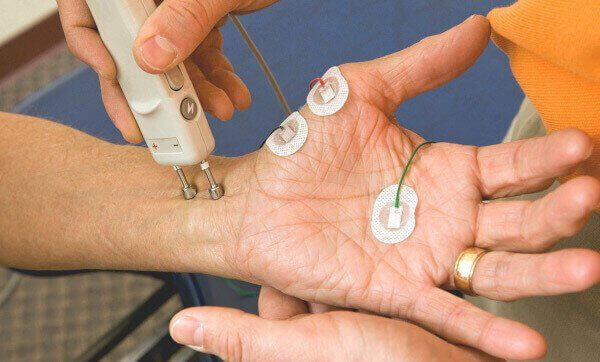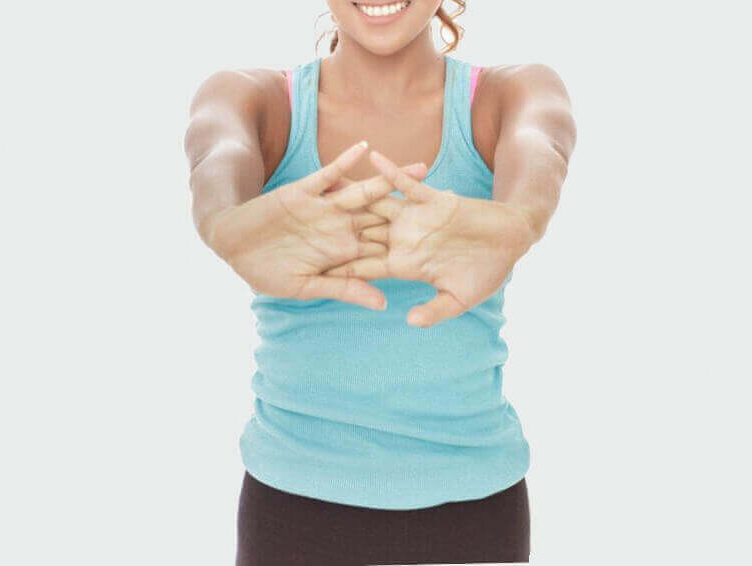Is Carpal Tunnel Genetic?
The answer is Yes - carpal tunnel is genetic.
This painful, numbing, and progressive disorder is definitely linked to family history. And recent studies show it's far more prevalent in women than anybody ever imagined.
Table of Contents
- Who gets carpal tunnel?
- Symptoms of carpal tunnel
- High risk jobs
- High risk health factors
- Why carpal tunnel is genetic
- Problems with collagen
- Anatomical problems
- Carpal tunnel is also a "female condition"
- Manual labor considerations
- Diagnosing carpal tunnel syndrome
- Treatment: 4 core carpal tunnel stretching exercises
- "Stop" stretching exercise
- "Prayer" stretching exercise
- Finger interlace stretching exercise
- Thumb stretching exercise
- Summary
Who gets carpal tunnel?
Symptoms of carpal tunnel
Most people with carpal tunnel syndrome have specific signs and symptoms in their hand or fingers. These can include any of the following:
In the beginning stages of the disorder, symptoms usually appear only at night. In time, symptoms start to appear during the daytime as well. In the
severe stage, symptoms are constant. The thumb and index finger are most likely to be involved first. The little finger never has symptoms.
High risk jobs
When you see your doctor he or she will perform a physical exam to diagnose the problem. During the exam, the first question the doctor will ask is if you have a
family member
with carpal tunnel syndrome. Having a family member with carpal tunnel almost confirms the diagnosis.
In other words, a major
risk factor for getting carpal tunnel is family history or genetics. Another risk factor is your occupation. Certain
jobs are high risk for getting carpal tunnel. In fact, some industries are infamous for having this disorder. For instance, with
hairdressers, carpal tunnel syndrome is number 4 among their
top 3 health concerns. And 15% of them already have this condition.
Other notable occupations infamously associated with carpal tunnel include:
High risk health factors
Other major risk factors for this disorder include certain health conditions. The conditions commonly making you more prone to getting carpal tunnel include:
Why carpal tunnel is genetic
Carpal tunnel syndrome
occurs in families. The hereditary nature of carpal tunnel syndrome means if you have it, then your children will likely sufferer as well. Likewise, if a sibling has it, then you're also at high risk. And if you're a female with a parent who had carpal tunnel syndrome, then you're at
extremely high risk.
No one is really certain which specific genetic factor or factors cause carpal tunnel syndrome. But two possible candidates have been proposed: problems with collagen and anatomical problems.
Problems with collagen
The pathology of carpal tunnel syndrome begins in the tendons and other connective tissues inside the wrist joint. Stiffer or less strong collagen fibers in tendons will make them less strong. This can lead to tendon failure. This then can result in tendon inflammation and swelling. The tendon swelling crushes the adjacent median nerve (see illustration) which is the basis of carpal tunnel syndrome.
Evidence suggests that
certain genes make tissue proteins (like collagen) which are
not
optimal for strength or suppleness. In other words, the collagen is defective. Examples are
defects in Type V collagen, which has been shown to be present in people with carpal tunnel syndrome.
Anatomical problems
Genes also control our physical characteristics. They contain the code for how tall or wide we become. They also code for the diameter of our limbs, and in particular, our wrists.
Statistics show that more slightly built ("small boned") individuals are
at higher risk for developing carpal tunnel syndrome. And if you inherited a smaller body frame
including
a smaller wrist diameter, you're at even higher risk for the disorder.
Carpal tunnel is also a “female condition”
The well-known fact is that females are
3-5 times more likely to develop carpal tunnel syndrome than males. This is why many scientists consider it primarily a
female condition.
But the reason it's a primarily female condition is not just due to more narrow wrists commonly seen in females. It's more than that. One hint comes from
Dr. Kramer and others. They have shown that females with carpal tunnel syndrome tend to have elevated levels of Type II collagen. Such an increase may change the
surface
of cartilaginous structures. This change impacts how tissues can handle mechanical loads, and by extension, can lead to tendon failure.
Manual labor considerations
The consequences of repetitive stress cannot be understated. Repetitively stressing your fingers and hands is a
major risk factor for developing carpal tunnel syndrome. And the major source of repetitive stress is related to the work environment.
Males make up
slightly more than half of the US labor force. And in that workforce, females produce only
10% of the manual labor performed.
Adjusting for this disparity means that women are exposed to manual labor
9 times less than males. Yet they are more prone to carpal tunnel! Therefore, the
probability of women developing carpal tunnel syndrome (under
equal
working environments) is not 2-3 times higher,
but over 30 times higher than in males!
By any measure, this reinforces the idea that carpal tunnel syndrome is primarily a "female condition".
Diagnosing carpal tunnel syndrome
The most reliable way a doctor can diagnose carpal tunnel syndrome is by using 3 "provocative tests". These are the Phalen, Tinel, and Durkan tests. They represent reliable ways to determine if you have carpal tunnel syndrome instead of another condition, like
wrist tendonitis.
Basically, the doctor taps and presses on your wrist area. If the doctor can "provoke" symptoms (or make them worse) then it's positive for having carpal tunnel syndrome.
Unfortunately, many doctors still rely heavily on electromyography (EMG), MRI, and CT exams to diagnose carpal tunnel syndrome. But the
American Academy of Neurology says such tests are valueless compared to the 3 simple and precise provocative tests. In other words, the electronic tests should be used only to
confirm the provocative diagnosis.
Treatment: 4 core carpal tunnel stretching exercises
The most important partner you have against fighting carpal tunnel syndrome is a stretching exercise regimen. If you do these
4 core stretching exercises every 1-2 hours, then your carpal tunnel symptoms will usually disappear in just a few weeks. And they certainly will never get worse.
1. "Stop" stretching exercise
2. "Prayer" stretching exercise
3. Finger interlace stretching exercise
4. Thumb stretching exercise
Summary
Carpal tunnel is related to genetics. Having a parent or sibling with this condition is a good way to predict if you’ll also see symptoms. In other words, you're at high risk if there's a hereditary link. Also, if you're female, you're at high risk as well. That means having both risk factors almost
assures
you'll get carpal tunnel syndrome. But you don’t have to let carpal tunnel control your life. Just perform the simple stretching exercises described here.
About













